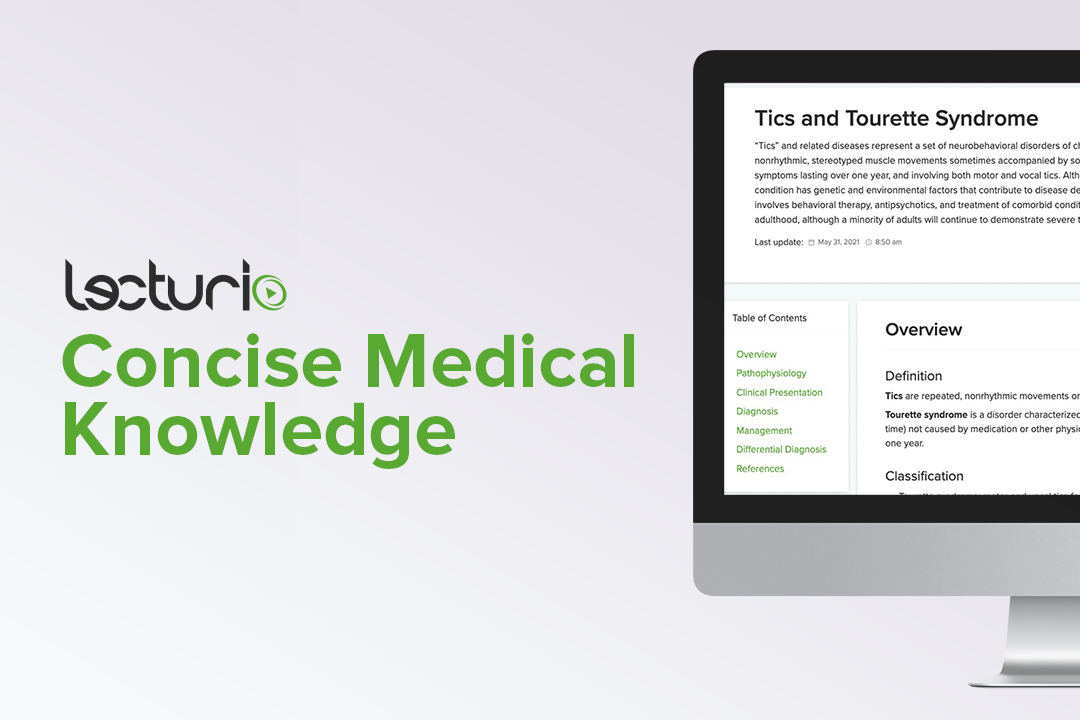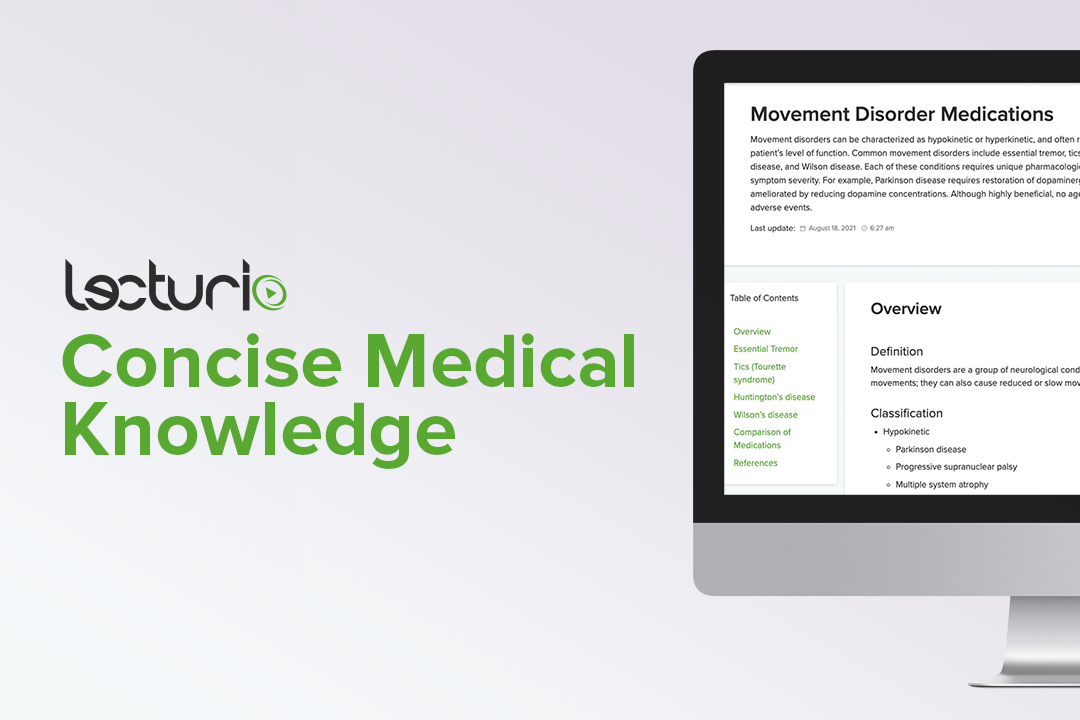Playlist
Show Playlist
Hide Playlist
Tics and Tourettes in Children
-
Slides Tics Pediatrics.pdf
-
Download Lecture Overview
00:01 In this lecture, we are going to discuss Tics and also Tourettes in children. 00:07 So Tics are involuntary repetitive stereotyped movements or vocalizations. 00:15 They are purposeless. 00:16 They are just a movement that moves for no particular no good reason. 00:20 And they can be very simple, they can be fairly complex. 00:24 Tourettes Syndrome is a Tics disorder that is specific to children and adults who have the condition. 00:33 This is defined as multiple motor tics. and at least one vocal tic. 00:39 And typically this vocal tics and motor tics are not necessarily simultaneous. 00:46 So, tics which are incredibly common especially on boys can be defined as simple or complex. 00:53 Let's go through this. 00:55 Simple tics will be things like blinking, facial grimacing perhaps a shoulder shrug or a head jerk or simply clearing of the throat. 01:07 The clearing of the throat one though is also very common in adults. 01:11 Complex tics on the other hand, which are less common may include a brief period of bizarre gait. 01:18 The patient may kick or jump. 01:21 They can be really unusual body gyration. 01:24 or patients may develop unusual speech patterns. 01:28 Coprolalia is when patients say swear words involuntarily. 01:33 Echolalia is when they repeat words that are just said to them. 01:36 And Palilalia is when patients repeat their own words over and over again. 01:43 So, tics are common they typically occur and primarily at an onset of around 6 or 7 years of age. 01:51 They are much more common in boys. 01:54 Rarely, they arise from previous neurological insults such as brain damage. 01:59 And they are usually worse when the patient is stressed out. 02:04 They can be surpressed for a brief periods of time. 02:08 a patient with a tic disorder can control them under a certain circumstance. 02:13 But then need to suddenly relieve them. 02:15 I have a patient once with Copalalia who can control his Copolalia while he is in a classroom. 02:21 but would literally need to run outside and relieve is copolalia in private. 02:29 They may persist even during sleep. 02:32 And so, that is how we can distinguish between tics and other behavior. 02:38 They can also wax and wane and change over time. 02:42 Typically boys with simple tics may even change what their tic is over several months and then eventually ease off and withdraw. 02:53 Typically, tics trouble caregivers or observers far more than they trouble the child with the tic. 03:01 And that's actually key. 03:02 A child generally is not truly bothered by their problem. 03:08 So, in terms of management of tics, generally management is supportive. 03:14 Because most of the time these resolve on their own, There is not too much that we necessarily do. 03:21 Usually, tics resolve in less than a year especially the transient types happening in these young boys. 03:29 And 2/3 of the children will have complete resolution of their tics. 03:35 However, some tic disorders are more permanent such as Tourettes. 03:40 90 percent of patients with Tourettes will also have another co-morbidity. 03:45 These includes things like Attention Deficit Hyperactive Disorder Obssessive Compuslive Disease or learning disabilities. 03:56 For these patients with more severe tics, we can manage them with medications. 04:01 These are rarely indicated. 04:04 These are limited to cases that cause embarassment or interfere with activity. 04:09 Haloperinol is an example of drug that we use or pimozide. 04:14 Both of these drugs can be used help to control tics. 04:18 Other medications have also started to be used for tourettes specifically including: ADHD medications such as methylphenidate and medications containing dextroamphetamine which can help increase attention and concentration, although can exacerbate tics at times. 04:35 Also, central adrenergic inhibitors such as clonidine and guanfacine might help control behavioral symptoms such as impulse control problems and rage attacks. Side effects may include sleepiness - that's a common question on multiple choice tests. 04:57 Side effects of tic medications can be severe. 05:00 especially Haloperinol. 05:02 Side effects may include cardiac conduction problems anticholinergic side effects such as dry mouth Bone marrow suppression and Esophageal dysmotility. 05:13 They may develop dystonia or hyperprolactinemia They can develop neuroleptic malignant syndrome. 05:21 And this can cause excessive sedation. 05:25 That is all I have for you today about tics and tics disorders in children. 05:29 Thanks for your children.
About the Lecture
The lecture Tics and Tourettes in Children by Brian Alverson, MD is from the course Pediatric Neurology. It contains the following chapters:
- Tics and Tourette’s
- Clinical Presentation of Tics
- Management of Tics
Included Quiz Questions
Which of the following is TRUE about tics in children?
- More common in boys
- Cannot be suppressed or controlled
- More common in girls
- Exclusively due to neurologic injury
- Only occur while the child is awake
Which of the following statements best describes Tourette's syndrome?
- It is defined as a condition with multiple motor tics and at least one vocal tic.
- It is defined as having simultaneous multiple motor tics.
- It requires the patient to present coprolalia to make the diagnosis.
- It causes multiple vocal tics and at least one motor tic.
- It often progresses to cerebral palsy.
Which among the following is an example of a complex tic?
- Body gyration
- Shoulder shrug
- Facial grimace
- Blinking
- Clearing throat
An 8-year-old child is brought by his mother who complains that her son is not "being himself" lately. When attempting to communicate with the child, you find that the boy keeps repeating the words that you have just said. Which of the following best describes this finding?
- Echolalia
- Palilalia
- Coprolalia
- Absence seizures
- Body gyration
Which one of the following statements is TRUE about children with tics?
- They can change their tic after several months.
- The tics subside when the child is stressed.
- The average age of onset is approximately 3–4 years.
- Children do not show tics during sleep.
- They rarely resolve on their own.
Which of the following conditions is usually associated with Tourette's syndrome?
- Obsessive compulsive disorder
- Autism spectrum disorder
- Narcissistic personality disorder
- Delusional disorders
- Depressive personality disorder
Customer reviews
4,0 of 5 stars
| 5 Stars |
|
0 |
| 4 Stars |
|
1 |
| 3 Stars |
|
0 |
| 2 Stars |
|
0 |
| 1 Star |
|
0 |
An important topic for the sheer number of children affected. Thanks!





